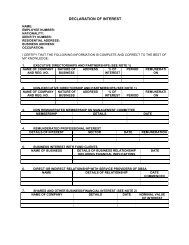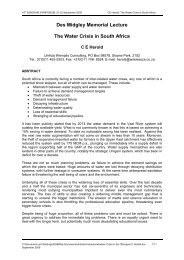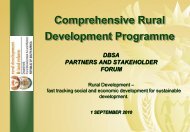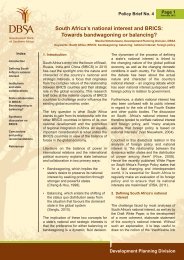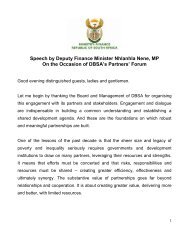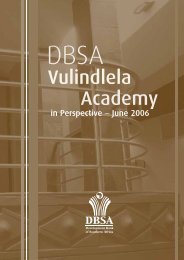A Knowledge Strategy
A Knowledge Strategy
A Knowledge Strategy
Create successful ePaper yourself
Turn your PDF publications into a flip-book with our unique Google optimized e-Paper software.
to the task at hand are dealt with by means of a ‘planners view’, ‘owners view’,<br />
‘designer’s view’ and ‘builder’s view’. The Zachman framework provides for a<br />
clear definition and distinction of three kinds of architecture – data, process<br />
(application), and network (technology). This framework is a breakthrough in<br />
information systems strategy development in that it clearly identifies the differing<br />
levels of detail or purpose of architectures.<br />
The Zachman framework, however, does not explain how to define the top two<br />
levels of the framework. It was left to Steven Spewak to take this Zachman<br />
‘architecture’ concept for information systems planning to the practical level of<br />
implementation. He introduced the architecture and the plans for implementation<br />
by means of the Spewak Enterprise Architecture Planning (EAP) methodology. The<br />
enterprise-wide architectures and plans created by the EAP methodology serve as<br />
blueprints for the subsequent technical design and levels of implementation, the<br />
‘designer’ and ‘builders views’, of the Zachman framework.<br />
In better aligning ICT to the Bank’s business, an enterprise architecture has been<br />
adopted that has shifted the focus from individual application systems<br />
(information ‘silos’) to a broader structured enterprise architecture methodology<br />
formulated around the works of Johan Zachman and Steven Spewak.<br />
The architecture, as implemented by the Bank, is depicted in Figure 5, which<br />
shows the data, applications and infrastructure sub-architectures of the ICT<br />
architecture. To establish the ‘as-is’ architecture we have moved upwards from the<br />
bottom layer, the infrastructure architecture, as this was the most stable and<br />
established. The focus, over the past few years and in some respects an opportunity<br />
afforded by the Y2K issue, has been on the applications architecture. To date the<br />
bank has implemented the applications architecture by updating and consolidating<br />
the information systems into a more coherent and business process aligned<br />
portfolio of transactional systems. This has resulted in a consolidated portfolio of<br />
transactional application systems that form the platform for the Bank’s data assets<br />
covering the financial, human resource, treasury and project and loan<br />
administration sub-business process areas.<br />
These systems, to a large extent, resolve the problem of the past where there<br />
existed multiple different data and information sources. Each data source in its<br />
specific silo was technically and functionally correct as each set of data was in a<br />
different state of processing or update. When viewed across a single value chain in<br />
the enterprise, however, the cumulative information did not make business sense.<br />
The future focus is now on the data architecture and linking this to the business<br />
process renewal initiatives. The objective is to refine the business processes from the<br />
perspective of efficiency and effectiveness remembering the shifting dynamics of<br />
the market and the need periodically to introduce new or even retire old products<br />
and services. By linking the data architecture to the workflow layers of the business<br />
processes we finally achieve the elusive goal of linking the ICT strategy to the<br />
business strategy as a whole. The linkages cascade directly from this business<br />
strategy all the way down to the infrastructure required to support this strategy.<br />
Development Bank of Southern Africa 45



